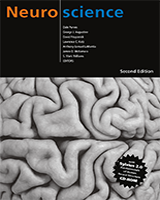By agreement with the publisher, this book is accessible by the search feature, but cannot be browsed.
NCBI Bookshelf. A service of the National Library of Medicine, National Institutes of Health.
Purves D, Augustine GJ, Fitzpatrick D, et al., editors. Neuroscience. 2nd edition. Sunderland (MA): Sinauer Associates; 2001.

Neuroscience. 2nd edition.
Show detailsThe arrangement of gray and white matter in the spinal cord is relatively simple: The interior of the cord is formed by gray matter, which is surrounded by white matter (Figure 1.11A). In transverse sections, the gray matter is conventionally divided into dorsal (posterior) lateral and ventral (anterior) “horns.” The neurons of the dorsal horns receive sensory information that enters the spinal cord via the dorsal roots of the spinal nerves. The lateral horns are present primarily in the thoracic region, and contain the preganglionic visceral motor neurons that project to the sympathetic ganglia (see Figure 1.10C). The ventral horns contains the cell bodies of motor neurons that send axons via the ventral roots of the spinal nerves to terminate on striated muscles. The white matter of the spinal cord is subdivided into dorsal (or posterior), lateral, and ventral (or anterior) columns, each of which contains axon tracts related to specific functions. The dorsal columns carry ascending sensory information from somatic mechanoreceptors (Figure 1.11B). The lateral columns include axons that travel from the cerebral cortex to contact spinal motor neurons. These pathways are also referred to as the cortico-spinal tracts. The ventral (and ventrolateral or anterolateral) columns carry both ascending information about pain and temperature, and descending motor information. Some general rules of spinal cord organization are (1) that neurons and axons that process and relay sensory information are found dorsally; (2) that preganglionic visceral motor neurons are found in an intermediate/lateral region; and (3) that somatic motor neurons and axons are found in the ventral portion of the cord.

Figure 1.11
Internal structure of the spinal cord. (A) Transverse sections of the cord at three different levels, showing the characteristic arrangement of gray and white matter in the cervical, thoracic, and lumbar cord. (B) Diagram of the internal structure of (more...)
- The Internal Anatomy of the Spinal Cord - NeuroscienceThe Internal Anatomy of the Spinal Cord - Neuroscience
Your browsing activity is empty.
Activity recording is turned off.
See more...